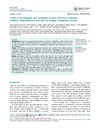Please use this identifier to cite or link to this item:
https://accedacris.ulpgc.es/jspui/handle/10553/69959
| Title: | Frailty in hemodialysis and prediction of poor short-term outcome: mortality, hospitalization and visits to hospital emergency services | Authors: | García Cantón, César Rodenas, Ana Lopez-Aperador, Celia Rivero, Yaiza Anton, Gloria Monzon, Tania Diaz, Noa Vega Díaz, Nicanor Jesús Loro Ferrer, Juan Francisco Santana del Pino, Ángelo Esparza, Noemi |
UNESCO Clasification: | 320506 Nefrología | Keywords: | Frailty Hemodialysis Hospitalization Mortality Outcome |
Issue Date: | 2019 | Journal: | Renal Failure | Abstract: | Background: Frailty is an aging-associated state of increased vulnerability, which raises the risk of adverse outcomes. Chronic kidney disease is associated with higher prevalence of frailty. Our aim was to estimate frailty prevalence in a hemodialysis population and its influence on short-term outcomes. Design: Observational prospective longitudinal study of 277 prevalent hemodialysis patients. Frailty was estimated through the Edmonton Frail Scale (EFS). Demographic and clinical data, comorbidity index, and laboratory parameters were recorded. A 29-month follow-up was conducted on mortality, including hospitalization, and visits to hospital emergency services in the first 12 months of this period. Results: According to the EFS, 82 patients (29.6%) were frail, 53 (19.1%) were vulnerable, and 142 (51.3%) were non-frail. During follow-up, 58.5% frail patients, 30.2% vulnerable, and 16.2% non-frail ones died (p <.005). In the analysis of survival using an adjusted Cox model, a higher hazard of mortality was observed in frail than in non-frail patients (HR 2.34; 95% CI 1.39–3.95; p =.001). During follow-up the hospitalization rate was 852 episodes/1000 patient-years for frail patients, 784 episodes/1000 patient-years for vulnerable patients, and 417 episodes/1000 patient-years for non-frail patients (p =.0005). The incidence ratio of visits to emergency services was 3216, 1735, and 1545 visits/1000 patient-years for each group (p <.001). Conclusions: Hemodialysis patients present high frailty prevalence. Frailty is associated with poor short-term outcomes and higher rates of mortality, visits to hospital emergency services, and hospitalization. | URI: | https://accedacris.ulpgc.es/handle/10553/69959 | ISSN: | 0886-022X | DOI: | 10.1080/0886022X.2019.1628061 | Source: | Renal Failure [ISSN 0886-022X], v. 41 (1), p. 567-575 |
| Appears in Collections: | Artículos |
SCOPUSTM
Citations
72
checked on Jun 8, 2025
WEB OF SCIENCETM
Citations
71
checked on Jun 8, 2025
Page view(s)
164
checked on May 17, 2025
Download(s)
217
checked on May 17, 2025
Google ScholarTM
Check
Altmetric
Share
Export metadata
Items in accedaCRIS are protected by copyright, with all rights reserved, unless otherwise indicated.
